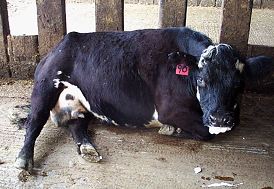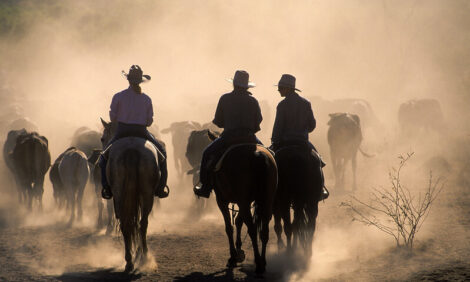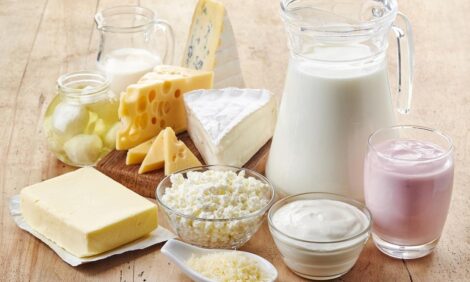



Climate and Crop Trends Provide Downer Cow 'Perfect Storm'
CANADA - Forage quality issues are leading to nutrient deficiencies in cattle on Canadian farms.A long winter and a cloudy wet summer are combining to stretch low quality rations and put increasing stress on animals as calving approaches, resulting in recumbent (downer) cows.
Along with challenges posed from the weather, the developing trend for livestock farmers to increase grain and oilseed plantings is seeing some of the country’s best meadow land cultivated leaving some enterprises with only old grass stands remaining.
Over the past three years durum and ex-durum wheat values have averaged as high as CAN$350/ton with Canola prices reaching in excess of $CAN600/ton. Farmers have subsequently been persuaded to increase arable cultivations to increase farm profits.
This trend has been particularly noted in Alberta, and brings problems. Especially when combined with a disrupted summer of late grass cutting and wet crops, says Grant Lastiwka, Forage/Grazing and Beef Specialist at Alberta Ag-info.
“A problem for some operations in western provinces seems to be a trend to produce poor quality forage over the last few years,” says Mr Lastiwka. “Cutting hay later means older hay is fed to cows which doesn’t hold the quality like alfalfa and as calving time approaches is not sufficient to sustain large animals.”
“This winter has been hard and people have not adjusted cattle rations properly- the weather has caught people out in the run up to calving when stress on the cow is at its peak - it's like a perfect storm.”
High fertiliser prices and a lack of rejuvenation work on old hay stands has served to compound the issue as farmers look to reduce spending as input costs spiral.
Mr Lastiwka adds that a further complication of cost cutting comes from extended outdoor grazing programmes which add further stress on in-calf cows. Such programmes have been difficult to implement this year because snow was brought by an early Alberta fall.
But being caught out by the weather can be expected across a large country like Canada, says Ryder Lee, Manager of Federal Provincial Relations at the Canadian Cattlemen’s Association.
“Every year we all take turns with regional weather fluctuations rotating around areas,” says Mr Lee. “This year has again seen the need for forage banks, herd downsizing and the shipping of cattle to where feed is available.”
However, a shift in weather through 2012 meant that north and western cattle areas, usually drought prone, swapped over with the eastern areas experiencing drought conditions, adds Mr Lee.
“Better growing conditions in the west meant we saw a west-to-east movement of fodder and some crazy forage prices. However the winter has been hard and long and this is particularly affecting older cows on operations looking to keep costs to a minimum.”
Consequently cattle health issues have been emerging as gestation progresses and cows are not being supplied with sufficient calcium and magnesium levels, vital for foetus development and cow health.
A recumbent cow - Photograph Courtesty of NADIS
NADIS, the National Animal Disease Information Service in the UK advises that, at this point in the year, it is important to monitor cattle and contact the veterinarian if problems arise.
Both beef and dairy cattle can get into problems if calcium, magnesium and phosphorous levels are low or imbalanced.
Generally speaking, milk fever- from calcium deficiency- is more common in dairy cows, with grass staggers tending to affect beef cows, NADIS states.
A growing calf places huge demands on cow calcium reserves. Calcium demand rockets by 80 additional grams as milk production rockets from 0-40 litres a day to feed a new-born calf.
NADIS recommends that farmers in any doubt over cow performance should take blood to arrive at a baseline level of where minerals are.
For grass staggers and milk fever issues, NADIS prescribes a calcium/magnesium combination injection with a calcium borogluconate solution for specific administration by a veterinary surgeon via slow intravenous injection.
Knowing a cow's history is important and NADIS recommends that preventative supplements - such as magnesium cobs - can improve nutritional herd balance.
However, according to Mr Lastiwka, this comes with palatability challenges and recommends some flavouring to improve rates of intake.
“Monitor cattle intake and adjust cattle diets accordingly,” advises Mr Lastiwka. “Make sure mineral is put out every day in an area where cattle spend the most time. Increasing palatability of supplements can be done with molasses flakes or distillers dried grains products.”
A final consideration, Mr Lastiwka adds, is to cut out bale shredding if possible.
Increasingly popular over the last ten years, bale shredding allows for fodder to be distributed in a time and labour efficient manner. However, Mr Lastiwka warns that the violent action of the shredder devalues the nutritional content of the bale.
It is the small fodder particles that have some of the highest calcium and phosphorous content which are lost to the floor through the shredding process.
The overall best advice to cattlemen as this spring is to monitor cows carefully and supplement rations despite the best intentions to cut productions costs, says Mr Lastiwka.
Supplement forage with grain is also advisable, he concludes. This will not replenish calcium/magnesium reserves but will provide important energy and relieve stress on an in-calf cow.
Michael Priestley
News Team - Editor
Mainly production and market stories on ruminants sector. Works closely with sustainability consultants at FAI Farms




